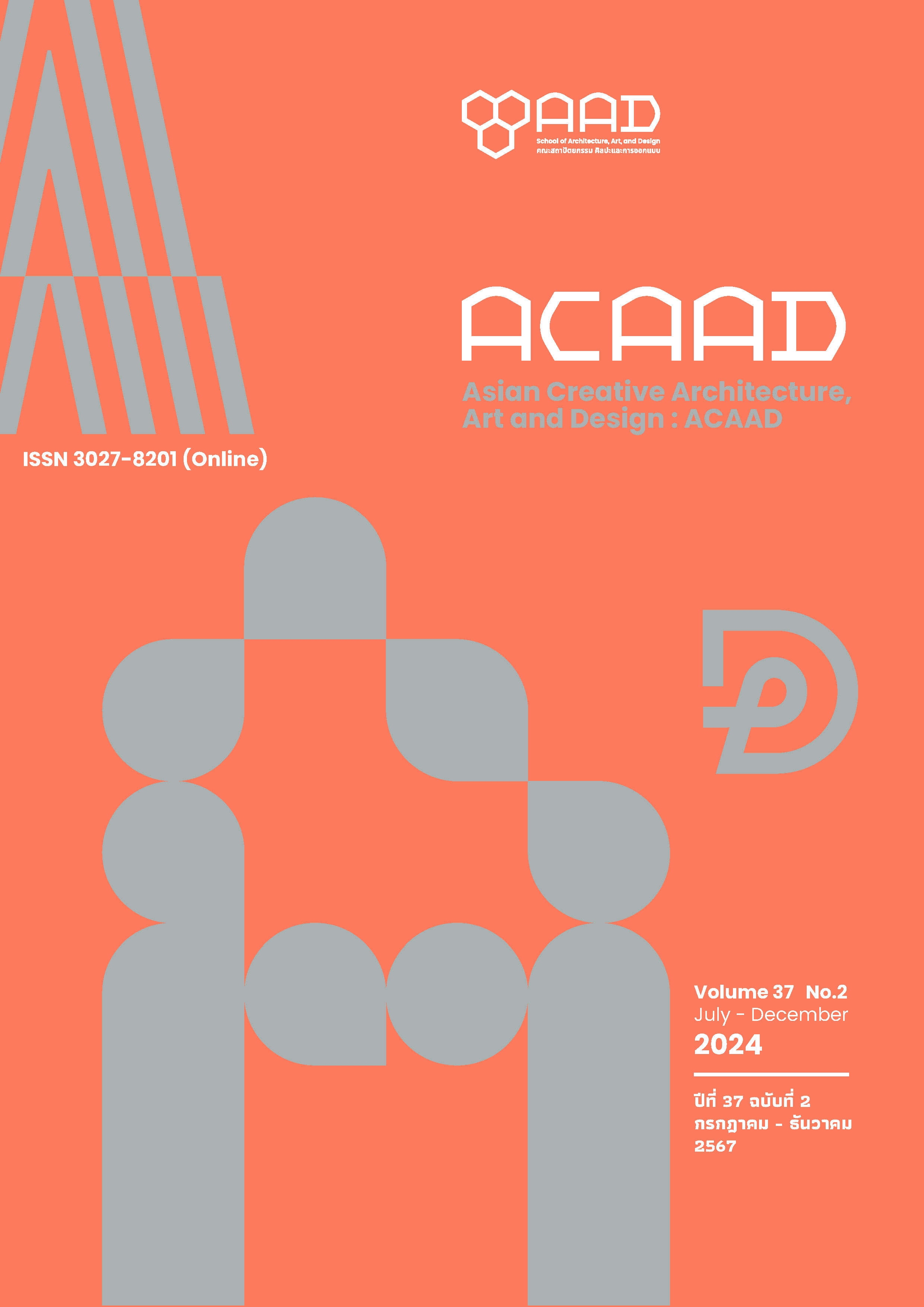The participatory design process for revitalization of vacant land within the municipal area of Nakhon Ratchasima City
Main Article Content
Abstract
Vacant land in communities play a significant role in their development, benefiting the public. A participatory design process can help create innovative solutions for revitalizing these vacant areas. In the case study of the municipal area of Nakhon Ratchasima City, this research project was conducted by surveying vacant areas to identify potential locations for revitalization. Data were collected from 400 questionnaires to determine how these spaces are used. The participatory design process involved community members as users and designers, to collaboratively brainstorm and implement solutions. The study found that in the municipal area of Nakhon Ratchasima City, there were vacant spaces owned by the state, such as Treasury Department (Ministry of Finance), Expressway and Rapid Transit Authority, State Railway of Thailand, Military land, Monastery land, totaling of 160.72 rai. These spaces can be divided into two categories: 1) unchanged community spaces, like those of Treasury Department, Ministry of Finance, Expressway and Rapid Transit Authority, and 2) transformed community spaces, like those of State Railway of Thailand, which had been repurposed for government offices, military housing, and open space. The vacant space, especially the underpass area managed by the Expressway and Rapid Transit Authority, was identified as a potential location for revitalization to meet the community's needs as a public space. Therefore, it was chosen as the pilot area for this participatory design. Through community engagement activities, including discussions, design trials, and presentations, it was determined that involving the community in the design process was crucial. Factors identified for revitalizing vacant spaces included creating spaces suitable for all ages, organizing continuous activities, and utilizing state-owned vacant land for public benefit by focusing on environmental restoration and promoting social activities to enhance quality of life.
Article Details

This work is licensed under a Creative Commons Attribution-NonCommercial-NoDerivatives 4.0 International License.
This work is licensed under a Creative Commons Attribution-NonCommercial-ShareAlike 4.0 International License.
Copyright Transfer Statement
The copyright of this article is transferred to Journal of The Faculty of Architecture King Mongkut's Institute of Technology Ladkrabang with effect if and when the article is accepted for publication. The copyright transfer covers the exclusive right to reproduce and distribute the article, including reprints, translations, photographic reproductions, electronic form (offline, online) or any other reproductions of similar nature.
The author warrants that this contribution is original and that he/she has full power to make this grant. The author signs for and accepts responsibility for releasing this material on behalf of any and all co-authors.
References
Aruninta, A. (2005). Managing Publicly Owned Urban Vacant Land Redevelopment Projects in Bangkok, Thailand. https://www.land.arch.chula.ac.th/data/file_20090921165323.pdf
Binder, T., Brandt, E., & Gregory, J. (2008). Design participation-a creative commons for ongoing change. Co Design, 4(2), 79–83. http://dx.doi.org/10.1080/15710880802114458
Carmona, M., Tiesdell, S., Heath, T., & Oc, T. (2003). Public Place Urban Space. Elsevier.
CharoenMueang, D. A. (2002). Sustainable City: Western Ideas and Experiences. Chiang Mai Rong Phim Saeng Sin. (in Thai)
Chomphaisal, J. (2017). Development Guidelines for Public Spaces from Residual Areas in the City: A Case Study of Areas Under Expressways. [Bachelor’s thesis, Thammasat University]. (in Thai)
Janthariwong, S. (2017). Developing the Quality of Life for the Elderly. Printed at the Faculty of Humanities and Social Sciences, Surin Rajabhat University. (in Thai)
Kokpol, O. (2009). Partners in Thought and Action: A Handbook for Public Participation for Local Administrators. S. Charoen Press.
Kulsrisombat, N., & Siri, Y. (2009). Abandoned Areas and Urban Revitalization: A Case Study of Under-Expressway Areas in Bangkok. Journal of Architecture, Faculty of Architecture, Chulalongkorn University, 58(2), 77-92. (in Thai)
Legal Reform Committee (LRC). (2014). Legal Reform: Rights and Welfare of the Elderly. Legal Reform Committee Office. (in Thai)
National Statistical Office Ministry of Digital Economy and Society. (2017). Thai Elderly Power Index. Text and Journal Publication Limited Company. (in Thai)
National Economic and Social Development Office. (2021). Guidelines for Sustainable Urban Development Planning in the Future. Academic Service Center, Chulalongkorn University. (in Thai)
Department of Public Works and Town & Country Planning. (2023a). Development Goals for Nakhon Ratchasima Province, 20 Year Plan (2023-2042). https://www2.nakhonratchasima.go.th/files/com_ebook_strategy/2023-06_16cad18ed19277c.pdf (in Thai)
Department of Public Works and Town & Country Planning. (2023b). Urban Planning Criteria and Standards 2006. https://www.dpt.go.th/th/dpt-standard/831#wow-book/ (in Thai)
Phujinda, P., Wongtawilap, T., Darikarnnon, S., Sae-io, K., Areepong, R., Hetanurak, P., Damrongkitkan, J., & Faungyong, P. (2021). Guide to Creating Community Health Spaces. Urban Health Promotion Center. (in Thai)
Ratchananthonkul, P. (2022). Guidelines for Developing Abandoned Areas into Community Public Parks: A Case Study of Wat Hua Lamphong Rukkhamin Park, Bangkok. [Master's Thesis Thammasat University]. (in Thai)
Sanoff, H. (2000). Community Participation Methods in Design and Planning. John Wiley & Sons.
Isarasena Na Ayutthaya, P. & Tree-rattanapan, C. (2017). Design Thinking: Learning by Doing. https://resource.tcdc.or.th/ebook/Design.Thingking.Learning.by.Doing.pdf
Woraratnachaiyapan, J. (2017). Green Spaces and Biodiversity in Cities: Coping with Local Government Climate Change Strategies. Sun Packaging Limited Company (2014). (in Thai)
Wangpatcharapon, S. (2020, February 12). Co-Creation: The Process of Collaborative Architecture Creation. http://asacrew.asa.or.th/feature19/ (in Thai)


